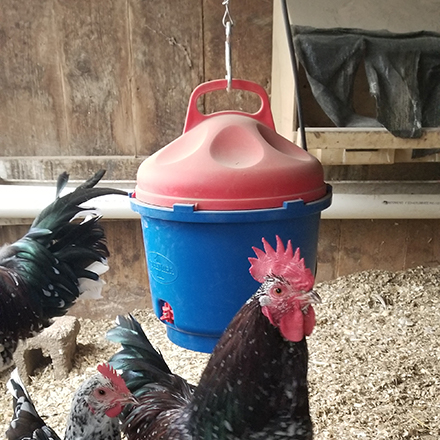
|
| |
|
Heated Poultry Waterers can be hung or set on a block. Birds may need training during initial use. Photo compliments of Mike Badger
|
| |
|
As a pastured poultry producer, the cold, wind, and dormant pastures require changes in management in order to ensure a healthy and productive flock. I’ll share a few recommendations for managing the layer and broiler flock in cold weather.
Draft-Free Housing
Your goal is ventilation without drafts. Ventilation brings fresh air into the house and exchanges the new air with the old air. Without this exchange, the air quality inside the house will become compromised, and you’ll fight condensation, ammonia, wet litter, and so on. Those conditions will lead to respiratory problems. The wet litter is a perfect way to have a coccidiosis outbreak.
Drafts blow on the birds directly, and when you’re talking about a cold wind, that’s going to stress the birds. In young birds, this could cause trampling. In older birds, you’ll likely see a drop in egg production, and the stress compromises the immune system making them susceptible to other health problems.
Square Footage Requirements
Comfortably housing the laying flock in a fixed location during the winter requires adequate space to allow the birds to express their natural instincts. I recommend between three and five square feet per hen, which you can spread out over the inside and outside areas, as available.
If you’re raising a commercial hybrid, such as a Hy-Line or ISA Brown, then you can start with three square feet per bird. The standard-bred (heritage) birds, such as Black Australorps will need more space per hen, and I’d recommend you house those birds at the five square feet per hen.
Energy and Protein Requirements
Hens eat for energy, not egg production. We feed a balanced ration to meet the hen’s energy requirements and to give the farmer eggs. When the temperatures drop, she needs more energy, so she eats more feed.
There are two problems with this increased feed consumption. First, there’s an extra expense. Second, she’s consuming more protein than she needs; As a result the hen lays jumbo eggs, which tend to have thinner shells. Hens that lay jumbo eggs typically lay less eggs.
If you want to maintain a large egg size and provide a balance between energy and protein, the easiest method is feed a handful of scratch grain per dozen birds each day.
Be cautious with the scratch because hens will over-indulge making them overweight, causing lower egg production and other health problems. I only use scratch grain in the winter to give the flock more calories.
Heated Water
If water is withheld from the hens for an extended period of time, they will dramatically and immediately decrease their lay rate. It might be something they don’t recover from if the withholding period was long enough.
Last winter, I moved to Premier’s heated poultry waterer. The lid keeps the water clean and thawed. For best results, hang the waterer so that the nipples are at eye level with the birds. An open heated bucket also works.
Too Much Light
Every winter, I participate in many discussions about cannibalistic hens. The most common scenario is hens in a greenhouse with fresh snow. The sun light is intensified as it comes through the greenhouse plastic, and when you refract sunlight off a fresh snow, for example, it gets more intense.
Your chickens do not like intense, bright light. They are domesticated jungle fowl, originating from the shaded canopies of a tropical environment. Bright light will stress them, and they will relieve their stress by pecking their flock mates. You will lose birds every day in this scenario.
The preventative step is to replace or cover the greenhouse plastic with something that blocks a significant portion of the light from coming through. You could use a shade cloth, an opaque white covering, or a covering that blocks 50% - 60% of the UV light.
Broiler Care in Cold Weather
When I started raising pastured poultry, I had several experienced producers tell me that they wouldn’t have broilers out on pasture beyond mid-October in Pennsylvania. I eventually learned why.
The fall weather is unpredictable. Don’t let the cool nights, warm days, changing leave colors, and the "unseasonably" warm days give you a false sense of security. Cold driving rains and chilled winds are ready to swoop in on the next cold front and create havoc on the health of your flock.
If you’re going to put broilers out on pasture in the transitional times of late fall and early spring, keep the birds dry, draft free, and ventilated. If you do, they can withstand the weather.
I see a lot of pasture shelters that are open on both ends and sometimes the roof doesn’t even cover the entire shelter side-to-side. This may work in July. When the low temperature averages around freezing, however, this housing is insufficient for cold weather. Enclose those shelters.
I used to visit my hoop houses in the rain, wind, and at night to observe flock behavior. This gave me the confidence to know my flock was safe and comfortable. I’d recommend you do the same.
|
